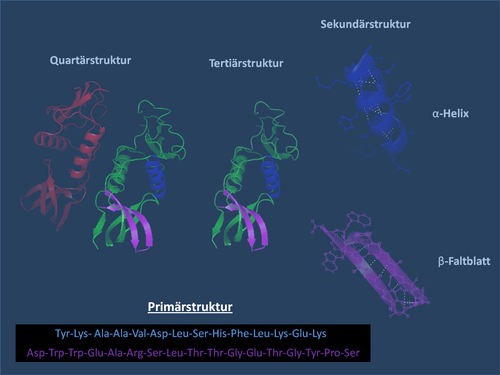Primary structure
In biochemistry, primary structure is understood to be the lowest structural level of a biopolymer , i.e. H. the sequence (sequence) of its basic building blocks. Since proteins are made up of amino acids , their primary structure is called the amino acid sequence . Accordingly, in the case of nucleic acids ( DNA and RNA ) , this is called the nucleotide sequence . In chemistry and materials science , the term primary structure also describes the sequence of synthetic polymers ( plastics ).
Effects on the shape of the protein
The shape of the higher structural levels ( secondary structure , tertiary structure , quaternary structure ) of a protein is derived from the primary structure. It is already determined by the sequence of the amino acids. The secondary structure usually forms in its final form during translation as a result of the interactions between the amino acids. In some cases, enzymes and other environmental influences are involved in this process (see also: prion ). The spatial structure fulfillment (tertiary structure) and, if necessary, the complexation with other subunits to protein complexes (quaternary structure) emerges from the secondary structure .
There is currently no reliable method for predicting the exact spatial arrangement of the amino acid chain based on the primary structure. As a rule, however, conclusions can be drawn about existing structural elements and the function of the protein from experience.
Relationship between nucleotide sequence and amino acid sequence
The amino acid sequence of a protein can be deduced from the nucleotide sequence of the nucleic acid in which it is encoded, since the genetic code is known and each codon is encoded for only one amino acid. The reverse is not possible as most amino acids have more than one codon. So they can be coded by different nucleotide sequences. The genetic code is therefore called degenerate.
The conversion of the genetic information of a gene into the amino acid sequence of a protein is part of gene expression and protein biosynthesis . The first part of these controlled processes is transcription , the second is translation .
There are agreed conventions for specifying the primary structure of proteins and nucleic acids.
- The amino acid sequence of proteins is written from the amino-terminal end ( N-terminus ) to the carboxy-terminal end ( C-terminus ).
- The nucleotide sequence of nucleic acids (DNA, RNA) is written from the 5'-phosphate end to the 3'-hydroxy end.
Analysis of the primary structure
Proteins
The Edman degradation is the classic method for sequencing of proteins and consists of three steps:
- Labeling of the first N-terminal amino acid by phenyl isothiocyanate.
- Cleavage of the marked amino acid.
- Identification of the split off amino acid, e.g. B. by HPLC or by ion exchange chromatography .
The 3 steps are repeated to sequence the next amino acid.
The method was largely automated and works for peptides up to a length of approx. 50 amino acids. Larger proteins are cleaved into fragments prior to analysis, which are sequenced separately. Recently, mass spectroscopic methods have become increasingly important in this area.
Nucleic acids
DNA
In 1976 Frederick Sanger developed a method for DNA sequencing . This is called the dideoxy method or chain termination method, since the synthesis reaction is terminated by the incorporation of dideoxy nucleotides into the DNA synthesis. By adding a small amount of a certain dideoxynucleotide to the synthesis reaction, the corresponding deoxynucleotide is partially replaced by the dideoxynucleotide, which causes the reaction to be terminated at this point. DNA fragments of different lengths result from the length of which the position of the replaced deoxynucleotide can be deduced.
This process has also been largely automated. The separation by electrophoresis usually takes place in a common gel track. The fragments are differentiated from one another by fluorescent markings that are detected by a laser .
RNA
RNA can be transcribed into cDNA by the enzyme reverse transcriptase and this DNA can be sequenced (see above).
Individual evidence
- ^ Löffler, Petrides, Heinrich: Biochemie und Pathobiochemie , 8th edition, Springer Medizin Verlag, Heidelberg (2007), p. 289, ISBN 978-3-540-32680-9 .
- ^ Wilson, Walker: Principles and Techniques of Biochemistry and Molecular Biology , 6th Edition, Cambridge University Press, New York (2005), pp. 380 ff., ISBN 978-0-521-53581-6 .
- ^ Horton, Robert et al .: Biochemie , 4th edition, Pearson Studium , Munich (2008), pp. 840f., ISBN 978-3-8273-7312-0 .
- ↑ Strachan, Read: Human Molecular Genetics , 4th edition, Garland Science, New York (2011), pp. 217 ff., ISBN 978-0-8153-4149-9 .
- ↑ Strachan, Read: Human Molecular Genetics , 4th Edition, Garland Science, New York (2011), p. 183, ISBN 978-0-8153-4149-9 .
